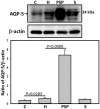Purple Sweet Potato Powder Containing Anthocyanin Mitigates High-Fat-Diet-Induced Dry Eye Disease
- PMID: 37108146
- PMCID: PMC10138706
- DOI: 10.3390/ijms24086983
Purple Sweet Potato Powder Containing Anthocyanin Mitigates High-Fat-Diet-Induced Dry Eye Disease
Abstract
Purple sweet potato (PSP) powder with anthocyanins possesses the ability to reduce oxidative stress and inflammation. Studies have presumed a positive correlation between body fat and dry eye disease (DED) in adults. The regulation of oxidative stress and inflammation has been proposed as the mechanism underlying DED. This study developed an animal model of high fat diet (HFD)-induced DED. We added 5% PSP powder to the HFD to evaluate the effects and underlying mechanisms in mitigating HFD-induced DED. A statin drug, atorvastatin, was also added to the diet separately to assess its effect. The HFD altered the structure of lacrimal gland (LG) tissue, reduced LG secretory function, and eliminated the expression of proteins related to DED development, including α-smooth muscle actin and aquaporin-5. Although PSP treatment could not significantly reduce body weight or body fat, it ameliorated the effects of DED by preserving LG secretory function, preventing ocular surface erosion, and preserving LG structure. PSP treatment increased superoxide dismutase levels but reduced hypoxia-inducible factor 1-α levels, indicating that PSP treatment reduced oxidative stress. PSP treatment increased ATP-binding cassette transporter 1 and acetyl-CoA carboxylase 1 levels in LG tissue, signifying that PSP treatment regulated lipid homeostasis maintenance to reduce the effects of DED. In conclusion, PSP treatment ameliorated the effects of HFD-induced DED through the regulation of oxidative stress and lipid homeostasis in the LG.
Keywords: anthocyanin; dry eye disease; high-fat diet; lacrimal gland; obesity; oxidative stress; purple sweet potato.
Conflict of interest statement
The authors declare no conflict of interest.
Figures











Similar articles
-
Purple Sweet Potato Ameliorates High-Fat Diet-Induced Visceral Adiposity by Attenuating Inflammation and Promoting Adipocyte Browning.J Agric Food Chem. 2025 Feb 12;73(6):3457-3467. doi: 10.1021/acs.jafc.4c08799. Epub 2025 Feb 2. J Agric Food Chem. 2025. PMID: 39895065 Free PMC article.
-
Protein-Bound Anthocyanin Compounds of Purple Sweet Potato Ameliorate Hyperglycemia by Regulating Hepatic Glucose Metabolism in High-Fat Diet/Streptozotocin-Induced Diabetic Mice.J Agric Food Chem. 2020 Feb 12;68(6):1596-1608. doi: 10.1021/acs.jafc.9b06916. Epub 2020 Jan 30. J Agric Food Chem. 2020. PMID: 31927925
-
Purple Sweet Potato Attenuate Weight Gain in High Fat Diet Induced Obese Mice.J Food Sci. 2017 Mar;82(3):787-793. doi: 10.1111/1750-3841.13617. Epub 2017 Jan 30. J Food Sci. 2017. PMID: 28135399
-
Development of high-throughput lacrimal gland organoid platforms for drug discovery in dry eye disease.SLAS Discov. 2022 Apr;27(3):151-158. doi: 10.1016/j.slasd.2021.11.002. Epub 2021 Dec 4. SLAS Discov. 2022. PMID: 35058190 Review.
-
The botanical profile, phytochemistry, biological activities and protected-delivery systems for purple sweet potato (Ipomoea batatas (L.) Lam.): An up-to-date review.Food Res Int. 2022 Nov;161:111811. doi: 10.1016/j.foodres.2022.111811. Epub 2022 Aug 25. Food Res Int. 2022. PMID: 36192953 Review.
Cited by
-
Physicochemical characterization of a composite flour: Blending purple sweet potato and rice flours.Food Chem X. 2024 May 19;22:101493. doi: 10.1016/j.fochx.2024.101493. eCollection 2024 Jun 30. Food Chem X. 2024. PMID: 38832302 Free PMC article.
-
A narrative literature review about alpha-lipoic acid role in dry eye and ocular surface disease.Acta Ophthalmol. 2025 Sep;103(6):e346-e363. doi: 10.1111/aos.17486. Epub 2025 Apr 10. Acta Ophthalmol. 2025. PMID: 40207422 Free PMC article. Review.
-
Antioxidant Activity of Anthocyanins and Anthocyanidins: A Critical Review.Int J Mol Sci. 2024 Nov 8;25(22):12001. doi: 10.3390/ijms252212001. Int J Mol Sci. 2024. PMID: 39596068 Free PMC article. Review.
-
Purple Sweet Potato Ameliorates High-Fat Diet-Induced Visceral Adiposity by Attenuating Inflammation and Promoting Adipocyte Browning.J Agric Food Chem. 2025 Feb 12;73(6):3457-3467. doi: 10.1021/acs.jafc.4c08799. Epub 2025 Feb 2. J Agric Food Chem. 2025. PMID: 39895065 Free PMC article.
-
Extraction of anthocyanins from purple sweet potato: evaluation of anti-inflammatory effects in a rheumatoid arthritis animal model, mechanistic studies on inflammatory cells, and development of exosome-based delivery for enhanced targeting.Front Immunol. 2025 Jun 9;16:1559874. doi: 10.3389/fimmu.2025.1559874. eCollection 2025. Front Immunol. 2025. PMID: 40552287 Free PMC article.
References
-
- Lemp M.A., Foulks G.N. The definition and classification of dry eye disease. Ocul. Surf. 2007;5:75–92. - PubMed
MeSH terms
Substances
Grants and funding
LinkOut - more resources
Full Text Sources
Miscellaneous

